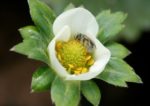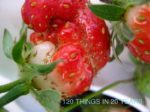Diverse Farms Better for Bees and Strawberries
 This morning there are Stanford researchers wandering around the farm with bug nets. They have been out several times this summer collecting data for a pollinator and pest study, to find out more about species interactions in agricultural landscapes. I’m looking forward to seeing the results.
This morning there are Stanford researchers wandering around the farm with bug nets. They have been out several times this summer collecting data for a pollinator and pest study, to find out more about species interactions in agricultural landscapes. I’m looking forward to seeing the results.
We have participated in many research studies over the years. One of the more interesting ones to me was a UC Berkeley study in our strawberry patch back in 2012. The UC Berkeley scientists used our strawberry field as one of 17 farm sites to study the effects of crop diversity and natural landscapes on native bee pollinators. Postdoc researcher Amber Sciligo compared monoculture strawberry fields to strawberry fields that were part of a diverse crop mix, and also compared strawberry fields in an agriculture intensive area to fields surrounded by large amounts of natural habitat. Since the 11 acres we farmed at the old Redman property we were leasing at the time were surrounded by hundreds of acres of monocrop agriculture, our strawberry field that year fell into the category of a farm with high crop diversity within an ag intensive landscape.
The researchers came to two main conclusions. (1) “Crop diversity and more nearby natural habitat increased the number and types of native bees on the farm.” They found that natural habitat greatly increased the bee populations (and number of different types of bees). They also found that crop diversity provides these benefits even in an ag intensive landscape. For their summer count, they found only 17 total bees in the ag intensive monoculture strawberry fields, while there were 223 total bees (12 different species) in the ag intensive polyculture fields (this included ours). The monoculture fields with neighboring natural habitat yielded 140 bees, while those fields with both crop diversity (polyculture) and natural habitat yielded 465 bees of 20 different species.
 The second conclusion was that (2) “Having more types of bees improved berry malformation and increased fruit quality.” This is interesting. First of all, strawberries are considered self-pollinating, but it turns out that pollinators lead to more complete pollination and therefore more perfectly formed fruit. Not only that but different types of pollinators serve different roles. Honey bees, for instance, “tend to visit the tops of the floral receptacle, while small native bees would tuck down in the bottom of the receptacle near the base of the flower petals.” So a diversity of pollinators provides more complete pollination. To determine this effect, the researchers covered some plants with bug proof mesh bags to keep out pollinators and compared the fruits produced with uncovered controls.
The second conclusion was that (2) “Having more types of bees improved berry malformation and increased fruit quality.” This is interesting. First of all, strawberries are considered self-pollinating, but it turns out that pollinators lead to more complete pollination and therefore more perfectly formed fruit. Not only that but different types of pollinators serve different roles. Honey bees, for instance, “tend to visit the tops of the floral receptacle, while small native bees would tuck down in the bottom of the receptacle near the base of the flower petals.” So a diversity of pollinators provides more complete pollination. To determine this effect, the researchers covered some plants with bug proof mesh bags to keep out pollinators and compared the fruits produced with uncovered controls.


The picture on the left shows a berry that is malformed due to incomplete pollination. The fruit is undeveloped around the smaller unpollinated seeds. The green berry at the right shows a different kind of malformation. The seeds are uniformly pollinated (same size), but the fruit has been sucked away in places by a pest called the lygus bug. A side project by Natalie Solares as a senior thesis found that the incidence of lygus bug abundance and damage were lower in polyculture farms compared to monoculture farms.
These research results are encouraging to me on several levels. For one thing it quantifies one small piece of the benefits of the diverse small farm model and surrounding natural habitat. It also shows that even if you have a few acres surrounded by large ag or urban development, what you do within your parcel can create a mini-environment favorable to a diversity of beneficial insects and to the quality of your produce.
Our strawberry patch this year is at our home farm with ample surrounding natural habitat as well as on-farm crop diversity—the best of both worlds. The native bees are plentiful around here – green sweat bees, bumble bees, small carpenter bees, yellow faced bees, dark sweat bees, hairy belly bees, cuckoo bees, hairy leg bees, sunflower bees… It’s nice to know that the way we farm is not only good for the bees, but the bees are also good for the strawberries.
* The study is called “Effects of natural habitat and crop diversity on pollination and natural pest management of strawberries.” The principal investigator was Berkeley professor Claire Kremen with assistant professor Kathryn De Master of the Department of Environmental Science, Policy and Management, and Amber Sciligo, postdoctoral researcher. It was also supported by the Berkeley Food Institute.
Search High Ground Site
High Ground Favorites Cloud
apples arugula basil beets braise broccoli carrots cauliflower celery chard cheese cilantro dressing fennel fish herbs kale leeks lemon lettuce Meyer lemon mint mushrooms nuts onions oregano parsley peppers pork potatoes quickles radishes salad sauce saute scallions soup strawberries summer squash tomatoes topping vegan vegetarian vinaigrette winter squash


